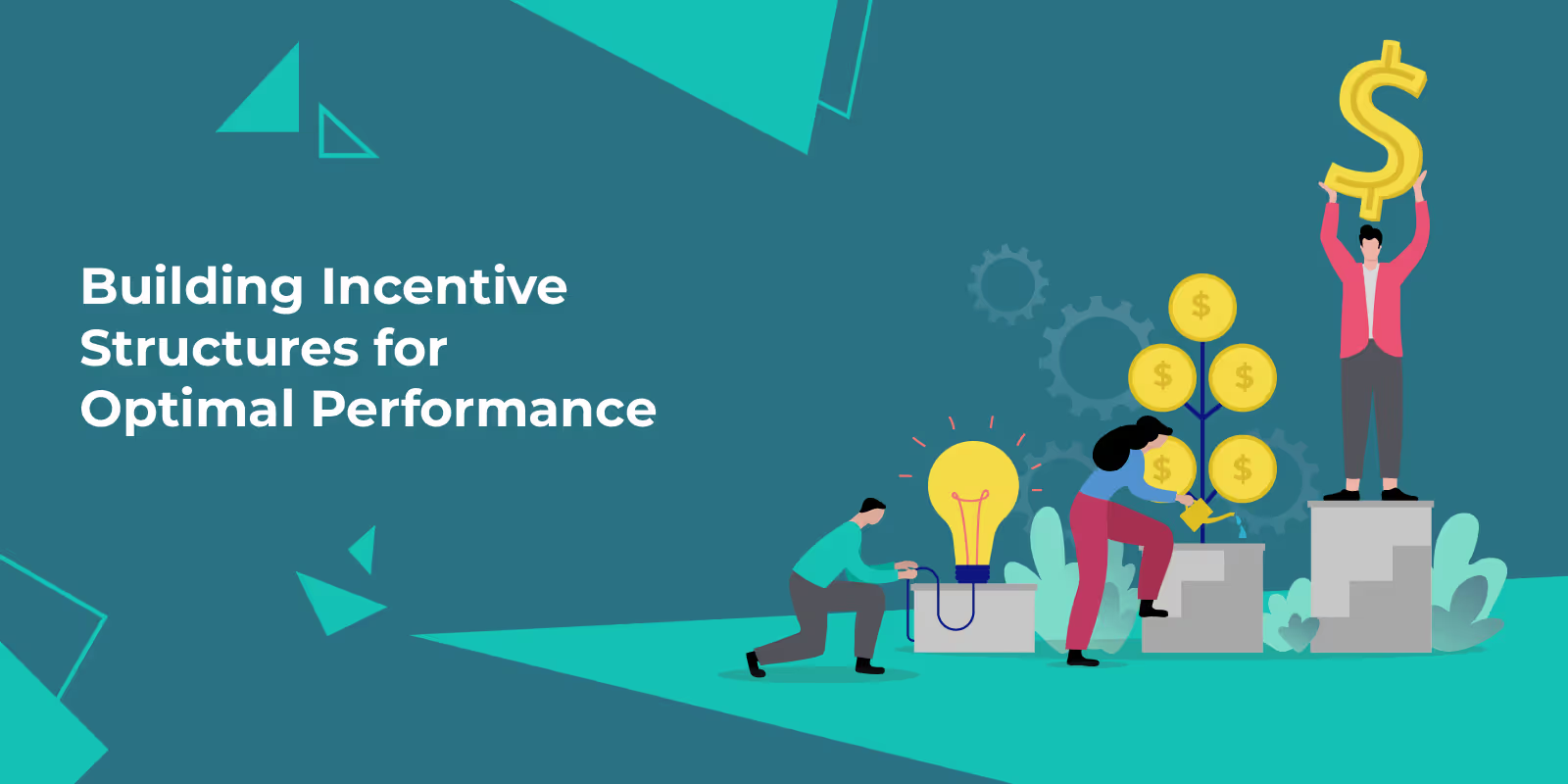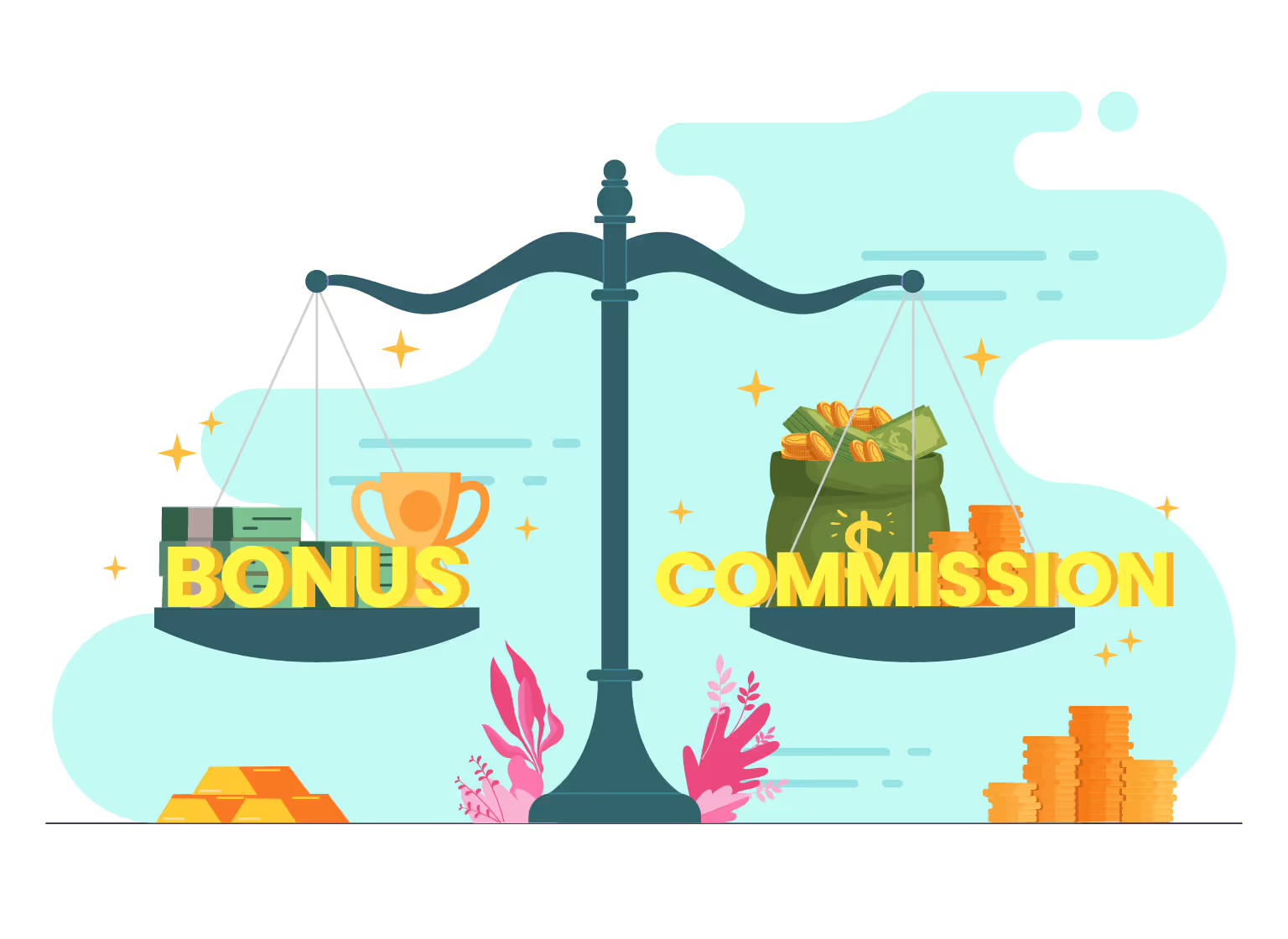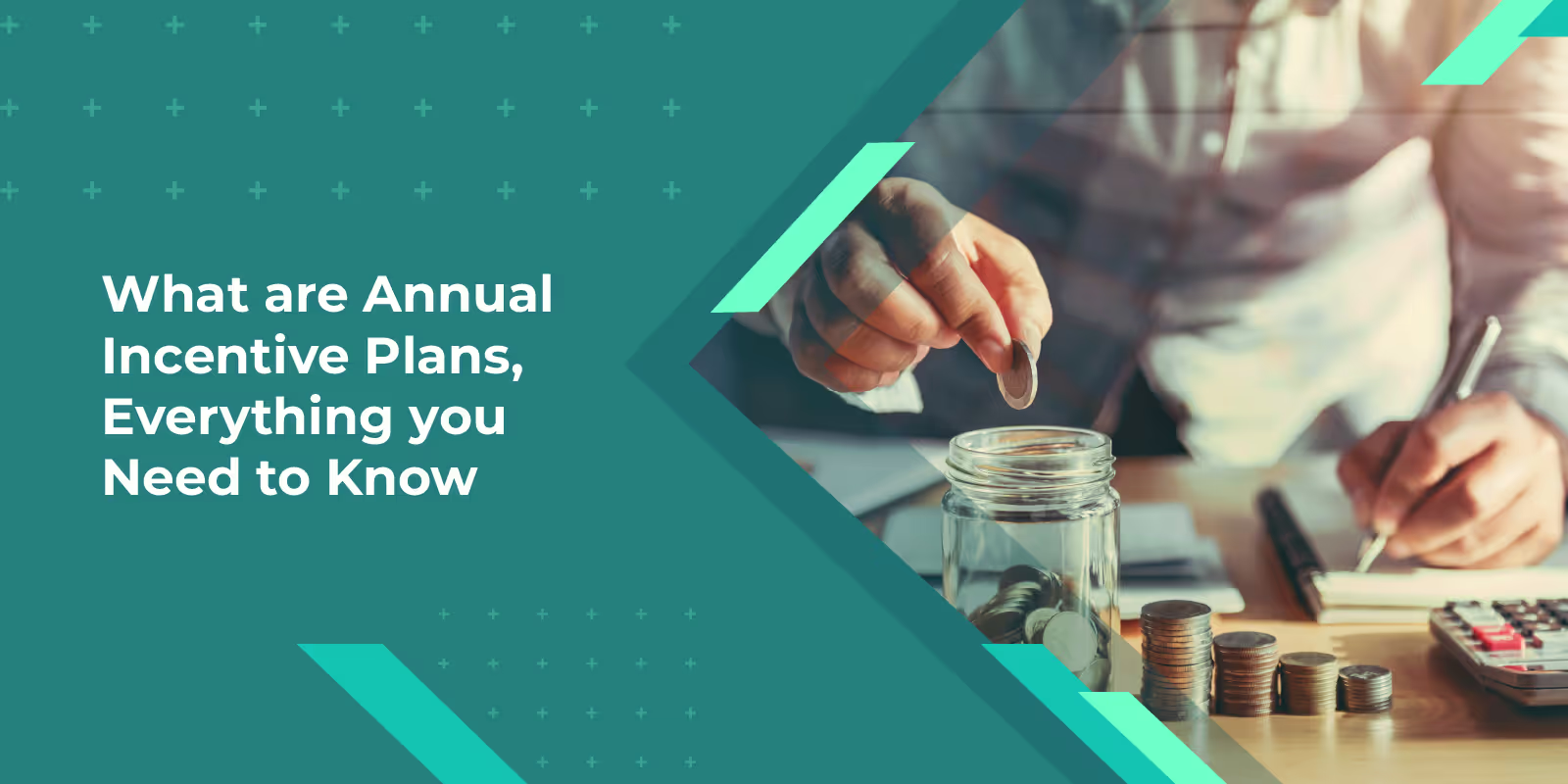
Blog
What are Annual Incentive Plans, Everything you Need to Know
April 19, 2024


Key Insights
A marathon cannot be won in a day nor a sale closed in a day.
Running a marathon requires preparing your mind and body for the long task, practicing regularly to reach the required level of stamina, and working consistently to reach the goal.
It is the reward of a medal, a sense of achievement, and satisfaction that pushes a runner to put in effort every day.
Closing a deal also requires similar focus, consistency, and patience. It is the promise of incentives and rewards that motivates a sales rep to persevere through the challenges and strike a deal.
At times it even takes 6 months to one year to close the deal!
This calls for the need for an effective and efficient annual incentive plan that can maintain the motivation and performance of the salesforce.
In this article, we will walk you through the annual incentive plan meaning, its key components, and its types. We will guide you to develop, implement, and manage an effective annual incentive program.
In addition, we will expose you to the potential challenges of incentive plans and suggest solutions to overcome them. The article concludes with a prediction for future incentive plans.
To read all and more, scroll down.
What are Annual Incentive Plans?
Annual Incentive Plans refer to the compensation program that is designed to motivate employees and ensure they achieve their goals and objectives of the organization on a yearly basis.
Annual incentive programs offer financial incentives like commissions, bonuses, and profit-sharing based on sales performance and target achievement.
Thus, an effective employee annual incentive plan will ensure motivation, drive performance, and help align individual goals with the larger organizational objectives.
Key Components of Annual Incentive Plans
While building your annual incentive plan, organizations must ensure that key components are included in it to ensure its effectiveness and efficiency.
Let's have a look at these key components and cross-check if your annual incentive plan is well-equipped.
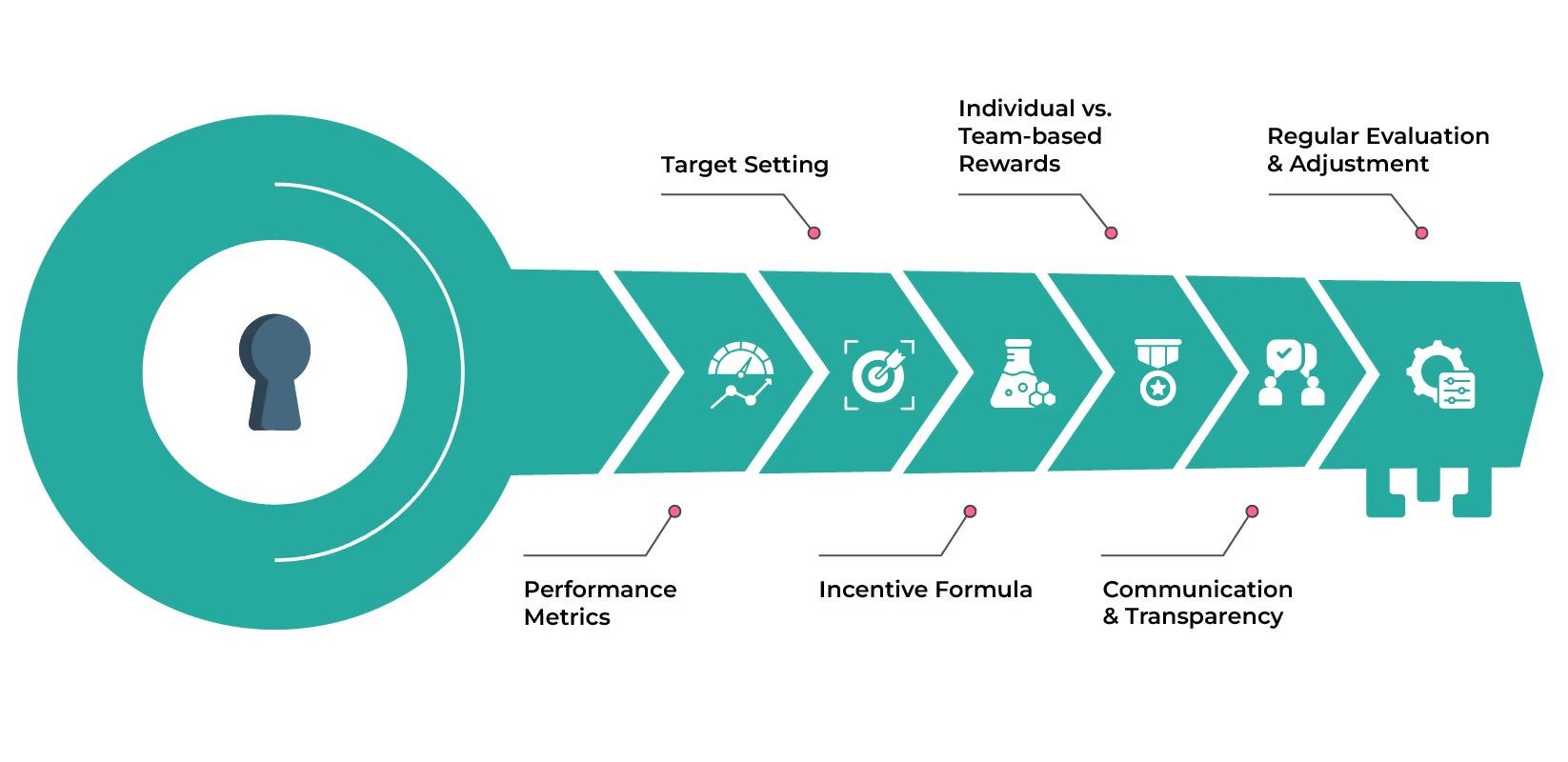
Performance Metrics
An ideal annual incentive plan example must have performance metrics which are parameters to measure the sales performance and qualification for incentives. It must be specific, measurable, achievable, relevant, and time-bound (SMART).
Some of the common performance metrics include lead conversion rate, revenue generation, win rate, target achievement, sales activities, etc.
Target Setting
Annual incentive plans are effective only when employees have clarity on their roles, responsibilities, target achievement, and overall goals. Communicating these specifics will help them understand what is expected of them and what needs to be done to achieve their incentives.
Organizations must ensure that each individual target is set based on their historic performance, industry trends, and market competition to ensure sales reps are not overburdened by their sales goals.
Incentive Formula
Annual incentive plans must outline how each sales incentive is calculated and must clearly communicate it with their sales reps. Companies must provide clarity on what percentage of the revenue will be earned as an incentive.
In addition to these incentive calculations, companies must specify what added benefit will be provided for sales reps who exceed their performance or sales targets.
Individual vs. Team-based Rewards
Annual incentive plans must differentiate between individual and team-based rewards. Individual incentives ensure sales rep motivation to achieve their sales targets while team incentives promote teamwork and coordination.
An effective annual incentive program is a combination of both that ensures that individual efforts and team collaboration lead to the overall achievement of company goals.

Communication and Transparency
Effectiveness of an Annual incentive plan can be ensured only when companies clearly communicate the specifics of the programs like eligibility criteria, performance metrics, etc.
In addition, businesses must ensure transparency in the commission calculation by communicating the commission percentage, calculation formula, etc. This fosters trust among employees in the objectivity and accuracy of incentive plans.
Regular Evaluation and Adjustment
Your annual incentive plan must be subjected to regular evaluation and adjustment. The industry is a dynamic space where trends change and competition increases. These changes can impact the buying and selling process.
Hence, depending on the market condition the incentive plan must be adjusted to ensure consistent sales performance and motivation without making the sales reps feel overburdened or demotivated.
Incorporating these key processes in your annual incentive plan will help ensure its effectiveness in motivating sales reps, driving performance, and aligning the individual sales goals with the larger organizational objectives.
For further reading, check Understanding the Basics of Sales Incentive Compensation.
Benefits of Implementing Annual Incentive Plans
Implementing an effective Annual incentive plan can provide several benefits for the employee as well as the organization.
Let's look at how an annual incentive program helps:
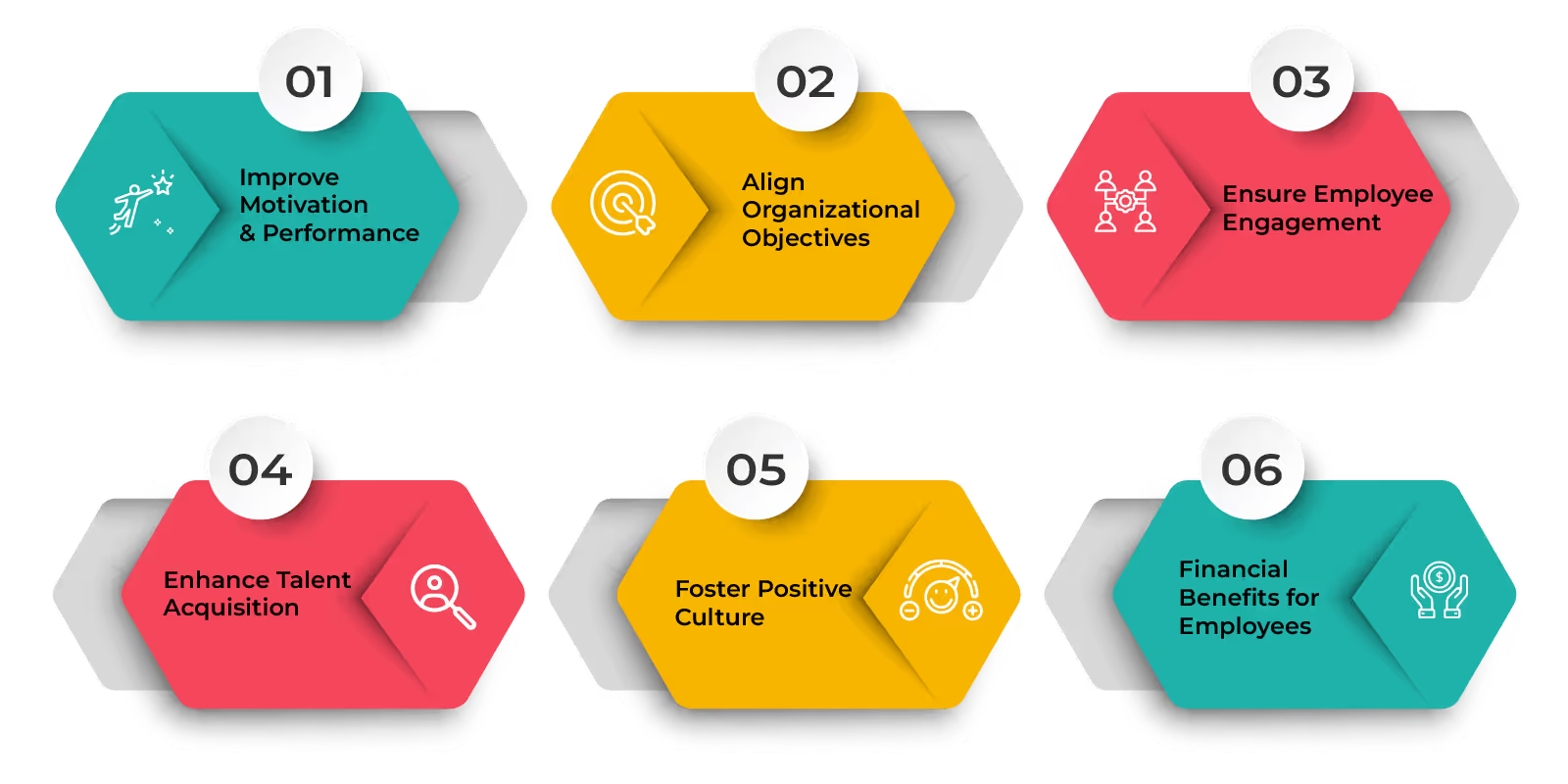
Improve Motivation and Performance
The primary function of any incentive plan is improved sales motivation and performance. When sales reps are assigned achievable goals with the promise of a reward, they will be motivated to achieve the goal and their targeted annual compensation.
Align Organizational Objectives
Annual incentive plan aligns all the individual sales efforts to achieve the larger organizational objectives. Setting SMART goals will ensure that sales reps focus their efforts and strategize their plans to drive growth and success for the company.
Ensure Employee Engagement
Annual Incentives are also a way of recognizing and rewarding the sales reps' efforts, contributions, and achievements. When employees feel that their work is seen and acknowledged it will enhance their engagement, improve retention, and foster a positive work culture.
Enhance Talent Acquisition
When companies offer competitive incentives, it will help in attracting top talents and high-performing sales reps to the organization. An annual incentive plan that is on par with the industry standards and offers financial rewards based on performance will help in recruiting and retention.
Foster Positive Culture
A well-communicated annual incentive plan will provide clarity on the expected performance and goal achievement. This transparency will foster better teamwork and coordination, improve communication between management and employees, and enhance employee engagement and trust. Ultimately, this contributes to building a positive work culture.
Financial Benefits for Employees
Annual incentive plans open opportunities for employees to earn more based on their performance and potential. This added opportunity will enhance their financial stability thereby ensuring employee morale and job satisfaction.
Annual incentive plan offers a wide range of benefits in all areas of sales management. However, to reap these benefits, companies must ensure effective planning, communication, and implementation of your sales incentive structure.
Types and Structures of Annual Incentive Plans
There are several types of annual incentive plans with their own characteristics and benefits. Some incentives for managers and executives and others cater to your employees.
Let's explore what these common types are to choose what best suits your organizational structure:
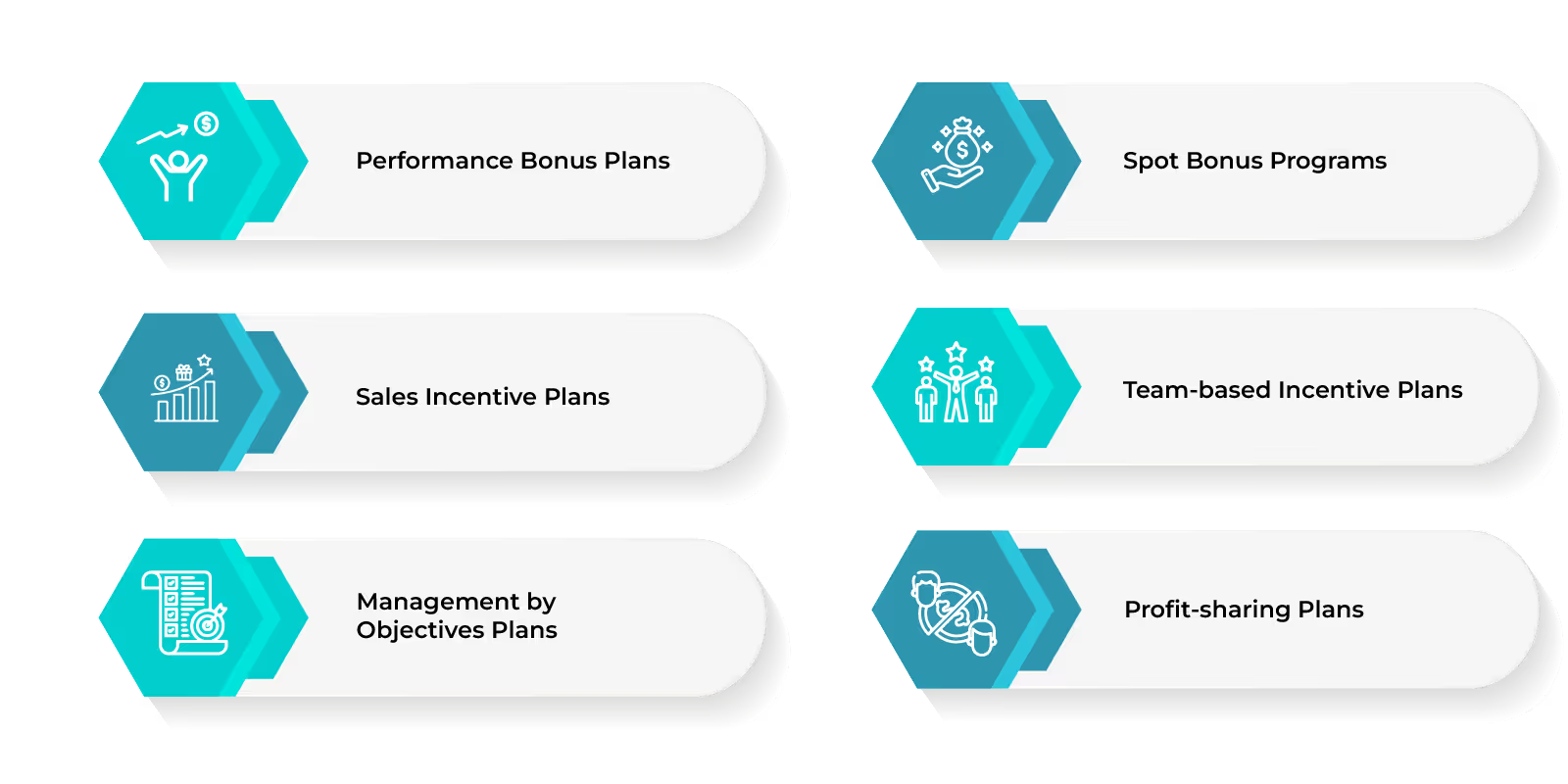
Performance Bonus Plans
Performance bonus plans are granted based on achieving specific performance milestones. This includes revenue generation, sales quota achievement, number of deals closed, etc. Based on these performance metrics, employees are granted their bonuses.
Sales Incentive Plans
Sales incentive plans are motivation tools to enhance sales performance, achieve targets, and drive revenue and growth. Incentives are earned based on key performance metrics like revenue generation, customer lifetime value, customer acquisition rate, deal size, etc.
Management by Objectives Plans
Under the MBO plans, employees are assigned a set of performance objectives and goals that align with the larger company objectives. When employees successfully achieve these performance goals they receive their incentives through a combination of qualitative and quantitative assessments.
Spot Bonus Programs
Spot bonus programs are immediate and one-time incentives used to reward employees for their exceptional performance or achievement. For example, when a sales rep brings a large size deal, managers can reward them with a bonus to appreciate their contribution.
Team-based Incentive Plans
Team-based incentive plans reward the collective efforts and achievements of a team. The incentives are granted upon achieving set goals or meeting performance expectations. The larger goal of team-based incentives is to promote teamwork and collaboration.
Profit-sharing Plans
Companies provide incentives in the form of profit-sharing among eligible employees. Under this incentive plan, a portion of the company’s profit is distributed among employees as a bonus for their achievements and contributions. It makes employees feel a part of the organization and work towards driving its growth and success.
Organizations develop their annual incentive plans by combining a number of these incentive plans depending on their budget availability, organizational structure, and business objectives.
For further reading, check A Comprehensive Guide to Types of Variable Incentives.
Developing an Annual Incentive Plan
Developing an effective annual incentive plan requires a systematic approach. To begin it must ensure that it motivates employees, aligns with the company objectives, and drives performance.
We have developed a step-by-step guide for developing an annual incentive plan that fulfills your requirements.
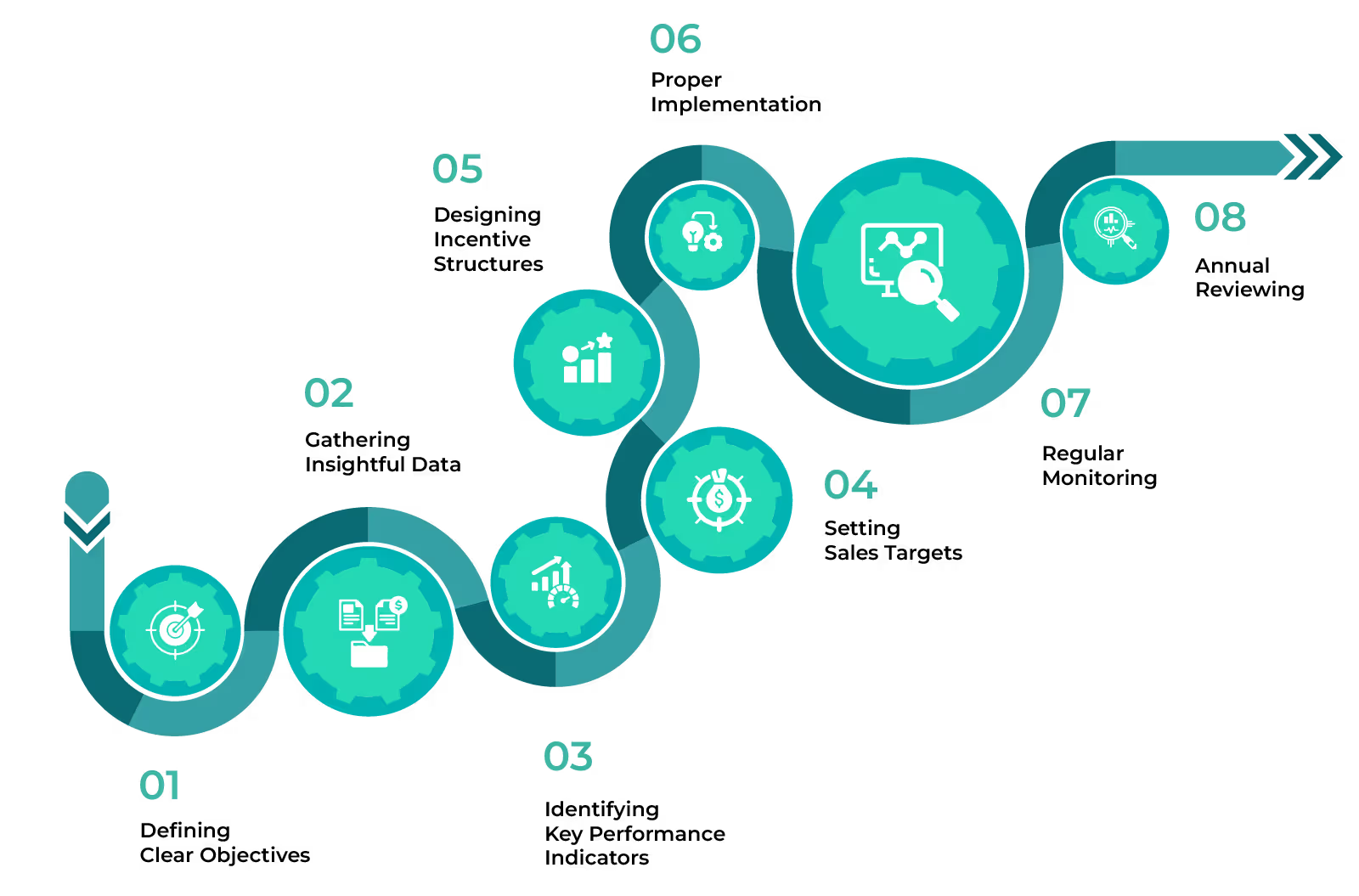
Defining Clear Objectives
Businesses must start by asking what they plan to achieve out of an incentive plan. Is it to drive performance, enhance target achievement, or just to motivate the salesforce? Defining your objectives will help in kick-starting the initiatives for developing an effective annual incentive program.
Gathering Insightful Data
Organizations must invest time and effort in gathering information on the industry trends, market competition, and financial landscape. Collecting these relevant and insightful data will help businesses set achievable goals and targets that motivate employees rather than overwhelm them.
Identifying Key Performance Indicators
Objectivity in sales performance evaluation is crucial. Identifying and incorporating your key performance indicators helps you measure salesforce performance based on a particular metric. This helps employees understand what is expected of them and how they are evaluated, bringing in trust and transparency in the evaluation process.
Setting Sales Targets
Businesses must set relevant and achievable targets for their employees. They must consider historical performance, market trends, and competition while determining the sales targets for each sales rep. This helps in assigning goals that motivate employees rather than overwhelm them.
Designing Incentive Structures
Businesses must be clear on how incentives are calculated and paid. You must determine whether incentives are based on individual or team performance, whether the commission rate is fixed or tiered, what are the eligibility criteria, and how often the incentives paid must be clearly decided and communicated among the salesforce.
Proper Implementation
The crucial part of developing an annual incentive plan is its implementation. Companies must ensure that the specifics of their incentive are clearly communicated among all employees, that all queries are addressed timely, and that there is transparency in the entire process.
Regular Monitoring
Companies put a lot of time and effort into development and implementation. However, the effectiveness of the employee annual incentive plan is ensured only through regular monitoring. Collecting feedback, checking for desired output, and finding areas of improvement must be made a routine process.
Annual Reviewing
Companies must review their incentive plan annually. Identifying the strengths and fixing the bottlenecks, adjusting the targets, and modifying the incentive formulas will help in maintaining the relevance of the incentive plan. Annual incentive plans must always be open to improvement and adjustments.
Following this systematic guide will help in developing an effective annual incentive plan that will derive all your expected results with success.
Implementation and Management
Developing an annual incentive plan requires time and effort. However, implementing and managing it requires consistency and commitment.
Just as the development process has a systematic process, implementation, and management also need a routine to ensure the plan’s effectiveness is maintained.
Let's create a step-by-step process for annual incentive plan implementation and management.
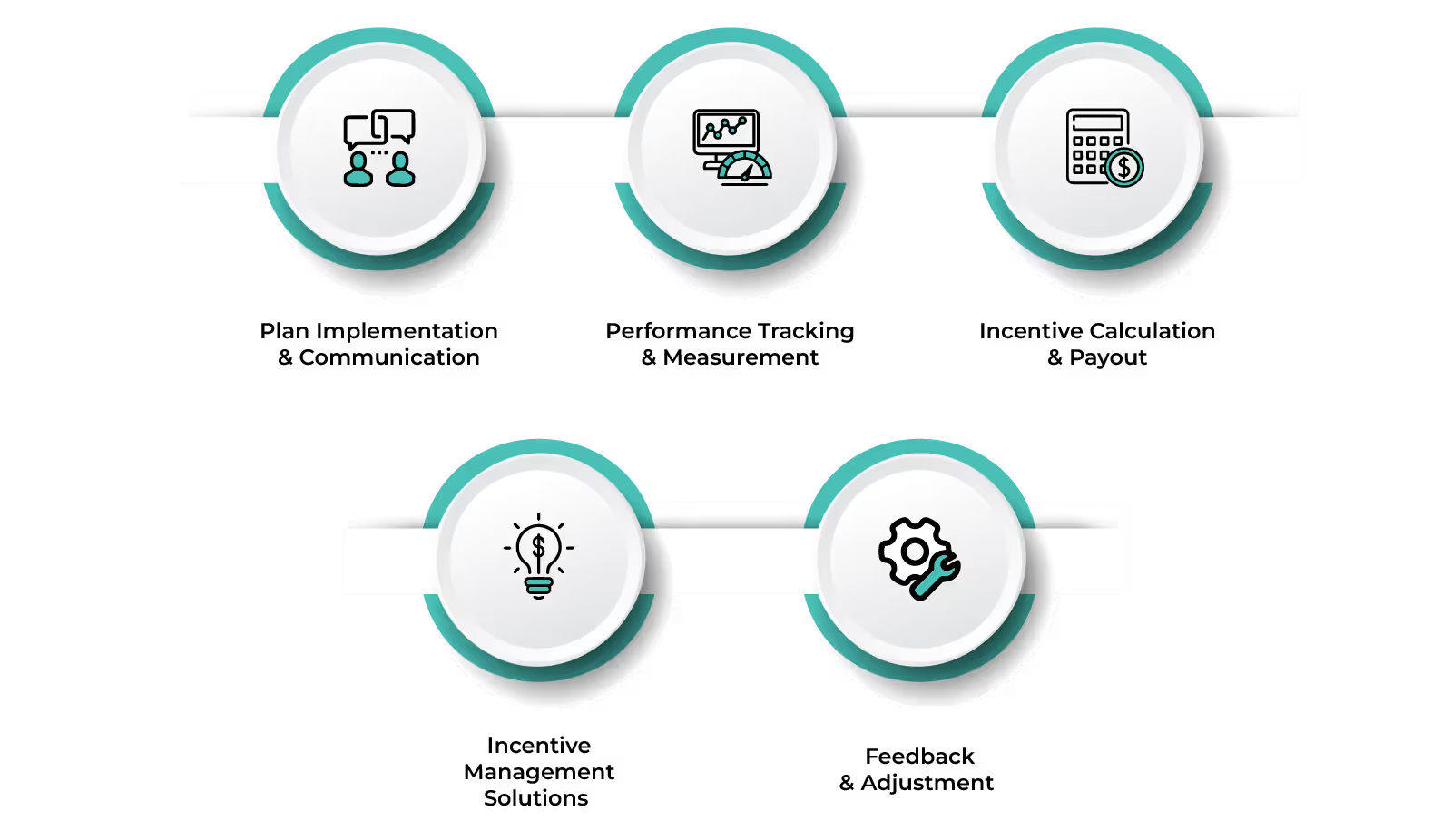
Plan Implementation and Communication
For effective implementation of an annual incentive plan, transparent and clear communication is crucial. Employees must be made aware of all specific aspects of the incentive plan from its structure to eligibility and all other relevant details.
Performance Tracking and Measurement
Annual incentive plans are also used to track and measure sales performance management. Hence, the effectiveness of the incentive program in assessing performance accurately and providing desired results must be monitored.
Incentive Calculation and Payout
To ensure the desired results out of an annual incentive program, companies must ensure accurate calculation and timely payout of the incentives. Employees must be clearly communicated about their commission rates, the payment period, and their expected commission to ensure its effectiveness.
Incentive Management Solutions
Incorporating incentive management solutions will help streamline your annual incentive plan by automating the performance tracking and incentive calculation process. It provides real-time visibility, ensures accurate calculation, and improves the overall effectiveness of the incentive program.
Feedback and Adjustment
A positive sign of good management is taking feedback from the recipients about the effectiveness of the incentive plan and asking for ways of improvement. This routine check will help ensure the intended motivation and drive to the salesforce as well as make the required changes to ensure its relevance and effectiveness.
In the implementation and management phase, businesses must keep a vigil on the incentive program by constantly ensuring awareness of the plan, tracking its effectiveness, gathering feedback, and being open to change and update.
Challenges and Solutions
Annual incentive plans strive to achieve multiple goals. From motivating employees, and driving sales performance to boosting revenue and business growth it touches on various realms of sales operations.
Hence, it's a crucial task that faces many challenges.
Let’s address these challenges and suggest solutions to overcome them and boost the overall performance.
No tool is completely fool-proof. Businesses must be proactive in understanding and addressing these challenges and resolving them according to their business model and requirements to derive the desired results.
Predictions for Future Trends in Incentive Plans
According to the IRF 2024 Trends Report published by the Incentive Research Foundation, here are a few future trends in incentive plans:
The report points out that even in 2024, the significance of incentives remains.
However, economic pressures and inflammation are posing challenges to incentive budgeting and constraints on the rewards. Hence, program owners will be shifting to a tiered system of reward distribution to maintain quality within budget constraints.
In the current scenario, the workforce is getting younger and thus the incentive priorities are also shifting. With millennials and Generation Z forming the majority there will be redesigning to resonate with the preferences of the younger workforce.
The younger workforce calls for frequent feedback, authentic recognition, and rewards such as merchandise, experiences, and incentive group travel
The 2024 trends show an increasing prominence of gift cards as rewards. Employees and program designers prefer gift cards for their flexibility, variety, and ease of distribution. It is often used for fun purchases or everyday essentials.
Program designers will increasingly leverage data-driven insights to customize merchandise rewards based on employee preferences and participation data. This helps in ensuring that employees are given customized gifts that make them feel rewarded.
Generative AI is becoming a disruptive technology in incentive and recognition programs. It has a transformative potential with the capacity for greater personalization, real-time performance monitoring, and data-driven decision-making.
In addition, 2024 will focus on leveraging technological platforms like incentive program management to enhance engagement and delivery of rewards.
Supercharge your Incentives this 2024 with Kennect. Our cutting-edge solution automates your entire sales incentives process, saving you time and ensuring accuracy. No more spreadsheets, no more errors – just efficiency.
ReKennect : Stay ahead of the curve!
Subscribe to our bi-weekly newsletter packed with latest trends and insights on incentives.
Thank you! Your submission has been received!
Oops! Something went wrong while submitting the form.
Your data is in safe hands. Check out our Privacy policy for more info





